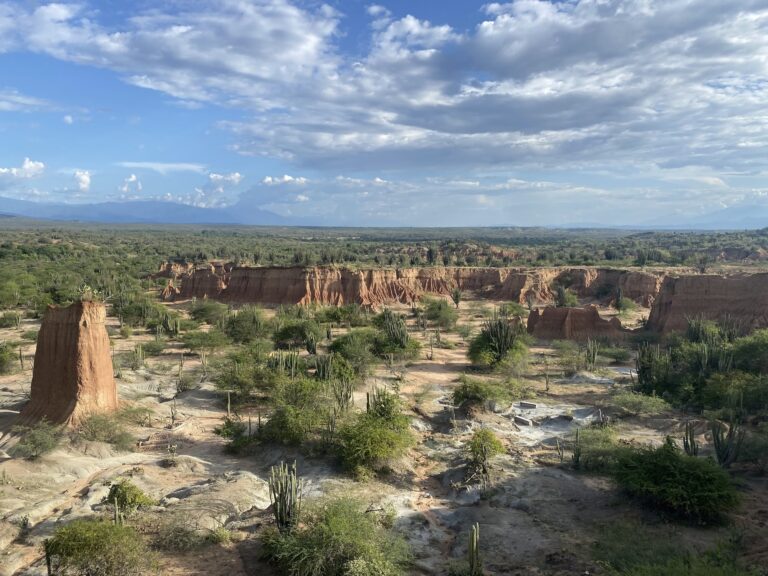How to Plan the Perfect Hike in Tayrona National Park
If you’re ever lucky enough to find yourself on the Caribbean Coast of Colombia, Tayrona National Park is not to be missed. It has stunning beaches, incredible wildlife, and some of the best hiking trails in the country. How you plan your visit will shape your entire experience, so I’m going to tell you everything you need to know before you go, including my favorite hiking route that most tourists skip.
Need a Place to Stay? Here’s some of my favourite places to stay near Tayrona National Park
$$$ Kantawa Hotel & Spa – Click here for rates and availabilty
$$ Portales del Tayrona Garden Hotel – Click here for rates and availabilty
$ Hostal Mama Tayrona – Click here for rates and availabilty
How to Get to Tayrona Park
Tayrona Park is located just east of the city of Santa Marta. The city is easily accessible by flight or bus from elsewhere in Colombia. It has three entrances, but for this post, we’ll focus on the eastern half, between the Calabazo and El Zaino entrances.
Though you can take taxis or private transfers, getting here by bus is very straightforward. Head to Santa Marta Market and ask for buses going to Tayrona. The bus to PNN Tayrona runs every 30 minutes from 6:30 AM to 6:30 PM every day. Sometimes they’ll simply put you on any bus heading east. You’ll have to ask the driver to stop when you need to get off. This is important because some of the accommodations and trailheads I recommend are not at the main entrance. The same applies if you are coming from the east, from places like Palomino or Riohacha.


It’s also possible to get to some of the beaches by boat straight from Taganga (near Santa Marta), but since this post is about the hikes, we will stick to the trails.
Park Entrances
The main entrance at El Zaino is open 7:00 AM to 4:30 PM, and Calabazo is open 7:00 AM to 3:00 PM. Hours can change in the low season, so it’s always best to check the official website. No matter how you plan your visit, enter as early as possible. The park can reach capacity during busy times, meaning you might be turned away later in the day.
Entrance fees for adult foreigners are 77,500 COP (~ $20 USD) in low season and 91,000 COP (~$23 USD) in high season, plus a mandatory daily insurance fee, whatever that means, of 5,000 COP (about $1.25 USD). This does not include accommodation, which I will explain later. You must bring your passport (sometimes a photo is accepted). If you want to be protected by real insurance from any accidents, check out Safetywing.
Tickets do not include overnight stays or food inside the park. Almost everything must be paid in cash, and while the Zaino entrance has recently started accepting cards, I wouldn’t count on it. On my first visit, I ran out of cash and had to ask a stranger to help pay for my bus out.
When to Visit
Before anything else, check whether the park is even open. Tayrona closes three times a year for maintenance and for indigenous communities to perform traditional ceremonies. Closures usually happen for most of February and for shorter periods in June and October, but exact dates vary each year. Always confirm with the official website before planning your trip.


When the park is open, the best time to visit is during the dry season from December to March, when trails are less muddy and the beaches are at their most beautiful. April to November is wetter, but rain showers are usually short and the park is quieter. Avoid Colombian holiday weekends if possible, as both Santa Marta locals and domestic tourists flock to Tayrona.
Hiking in Tayrona
What NOT to do
This part is important because most visitors get it wrong. The majority either rush through Tayrona as a day trip or spend the night in the most crowded areas. The typical route starts at El Zaino, where you can take a shuttle to the trailhead. The trail itself is flat and easy, with just a few short climbs and steps over rocks.
You’ll pass through palm-lined paths, spot monkeys, and arrive at Arrecifes Beach, home to a massive campground, basic tents, hammocks, and a couple of restaurants. From there, most people continue to La Piscina and then Cabo San Juan de Guia, the park’s most famous beach. This is where the crowds are at their worst. Just beyond Cabo is Playa Nudista (the nudist beach), and after spending the night at Arrecifes or Cabo, most visitors backtrack the same way out.


Another thing to skip is the horse riding option. While it’s marketed as a shortcut, the trail is flat and manageable, and making horses carry tourists and luggage in the heat is unnecessary and unpleasant for the animals.
What to do Instead
If you want a quieter, more rewarding hike that avoids backtracking, try my favorite two-day route. You can hike it in either direction, but I recommend starting west at Calabazo and finishing at El Zaino. This way, you get the steep climbs out of the way first and save the best parts for the end.
From Calabazo, you can walk the 4 km uphill to the start of the main trail, passing small villages along the way. From the park entrance, there is an option to take a motobike to the “start of the trail”, but if you’re hiking, you might as well walk it, right? Stop for lunch at La Cima Tayrona, which has a great viewpoint and a camping area. Continue through indigenous communities, then descend to Playa Brava, a secluded beach with only a few hammocks and cabins on stilts right by the sand. This is the perfect place to spend the night. Day one is about 8 km with 350 meters of climbing.


On day two, start early for the 300-meter climb out of Playa Brava, a different trail from the one you came down. The trail winds through dense jungle and is usually completely empty. At around the 5 km mark, you’ll reach Playa Nudista, the first of several coastal beaches. From here, the trail is flat, passing through Cabo San Juan, La Piscina, and Arrecifes. The last stretch before the shuttle road has some of the park’s best views, so take your time. The road to the exit is a boring 7 km, but you can catch a shuttle to El Zaino if you prefer.
Variations are easy — you can reverse the route, hike it all in one day, or add extra nights in Playa Brava or Cabo.
Visit Tayrona with a Tour
All of this planning sound like too much work? You can also visit Tayrona with a tour and get all of the logistics sorted for you.
Where to Stay
Outside the park, the best budget-friendly base is Santa Marta, where you’ll find plenty of hostels, hotels, and restaurants. However, I recommend staying closer to the park at least the night before you start, so that you can get going early in the morning. There are excellent eco-lodges and guesthouses, such as Mama Tayrona near the Calabazo entrance or the mid-range Portales del Tayrona Garden Hotel. For a luxury stay, have a look at Kantawa Hotel & Spa. Near the Zaino entrance, there are many other options, including the Journey Hostel, popular among backpackers. For mid-range, try Senda Koguiwa, and on the high-end, there are places like Senda Watapuy.


Inside the park, your options are limited to campgrounds, hammocks, or rustic cabins. At Playa Brava, you can stay in simple huts just steps from the water or hammocks, which are $50,000 COP (~$13). The huts tend to book out, so make sure to book them in advance. Cabo San Juan offers hammocks with ocean views, but they also book up quickly. Arrecifes has the largest camping area with tents and hammocks, plus restaurants. Keep in mind that electricity, showers, and comfort are basic throughout the park, and usually everything is paid in cash. If you’re looking for luxury in the park, you’ll want to book into Arrecifes Refugio Natural.
Bonus Story
I don’t want to scare you away from visiting this incredible national park, but my first experience there was unforgettable for all the wrong reasons.
We had started our hike from the Calabazo entrance toward Playa Brava, passing through a small indigenous community along the way. The locals were kind and welcoming, but they warned us not to swim at the beach. It struck us as strange—we weren’t anywhere near the water yet. When we finally reached Playa Brava, the warning came again, only this time they explained that someone had drowned there recently. We assumed the waves must be rough and that the warning was just a precaution.
The beach itself was breathtaking—remote, quiet, and completely untouched. We stretched out in the sand to relax, but the heat became unbearable, so we carefully walked down to the shoreline to dip our toes in. We stayed cautious, remembering the repeated warnings. Just a few minutes later, the unimaginable happened: the body of a young indigenous boy drifted toward us in the surf.
Completely shocked and unsure of what to do, we rushed to get help from the nearby community. The locals pulled the boy’s body out of the water, and reality hit us—they hadn’t been exaggerating at all.
Because Playa Brava is so isolated, there was no phone signal, no boats, and no vehicles to call for help. The community had to send someone on foot back up the mountain to alert the boy’s parents. Hours later, they returned with the family and a small Colombian rescue team. That night, under the darkness of the forest, they carried the boy’s body back up the mountain.








